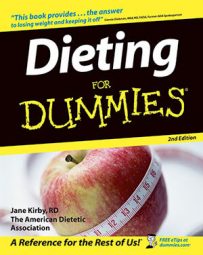If losing weight is your goal for the New Year, dieting doesn’t have to mean eating terrible food. You can rework standard cooking methods to make them lowfat and low calorie, and some foods can be used as substitutes, making them great, healthy stand-ins for others. Every calorie-conscious cook should use the following tricks:
Sauté onion and garlic the lowfat way: When a recipe calls for onion and garlic to be cooked in oil, use a nonstick pan and 2 tablespoons of water in place of the oil. Use low heat and cover the pan to coax the natural juices out of the onion and garlic.
Make and use yogurt cheese: Spoon a 16-ounce container of plain, lowfat yogurt (made without gelatin) into a colander lined with cheesecloth or into a paper filter-lined coffee cone. Place it over a bowl in the refrigerator and allow the yogurt to drain for 8 to 24 hours, depending on how firm you want the “cheese” to be. Use well-drained yogurt as a cream cheese substitute.
Make your own vinaigrette salad dressing: Use 1 part oil; 1 part flavorful yet mellow vinegar, such as balsamic; and 1 part strong black tea or citrus juice, such as orange or grapefruit.
Roast garlic: Roasted garlic is a buttery, nonodorous spread that you can substitute for mayonnaise in potato, pasta, and chicken salads. It’s also delicious when spread on bread in place of butter or oil. Bake a head of garlic, trimmed to expose the cloves and sealed in foil with a scant tablespoon of water, for 45 minutes in a 400 degree F oven. Unwrap and cool it until it’s easy to handle and then simply squeeze the garlic from its skin.
Use aged cheese: The stronger the flavor, the less you need. When a recipe calls for a mild cheese, such as mozzarella or Monterey Jack, whose flavor often disappears when cooked, substitute aged cheddar, Asiago, imported Parmesan, or an aged and smoked cheese, such as smoked Gouda.
Roast vegetables: Roasting vegetables in a hot oven caramelizes the natural sugars that they contain. Set the oven to 450 degrees F. Slice large vegetables in half or cut them into i/2-inch thick slices and arrange in a single layer. Lightly spritz them using a pump bottle filled with olive oil to prevent them from drying. Cook them according to the following suggested guidelines:
Beet halves: Roast for 1 to 1-1/2 hours.
Winter squash slices: Roast for 8 to 12 minutes.
Carrots: Roast for 15 to 20 minutes.
Green beans and red pepper strips: Roast for about 12 minutes.
Onion halves: Roast for about 30 minutes.
Sweet potato slices: Roast for 15 minutes.
Summer squash or zucchini slices: Roast for 5 to 8 minutes.
Eggplant slices: Roast for 10 to 15 minutes.
Use sun-dried tomatoes in place of bacon: To duplicate the mellow richness and smokiness that fatty pork adds to soups, stews, and pizzas use chopped sun-dried tomatoes, after softening them in a little hot water.
Substitute fruit for fat in baked goods: You can’t remove all the oil or butter from baked goods and still have something worth eating. But you can reduce the fat to about one-quarter of the original amount and replace the rest with prune pie filling (lekvar), apple butter, or applesauce.
Brown butter to use less: Heat a bit of butter in a skillet until it becomes fragrant and begins to turn nutty brown. A tiny bit drizzled over corn on the cob, eggs, or vegetables tastes like you’re using much more.
Toast nuts for greater flavor bang: Heat the oven to 350 degrees F and toast nuts — on a cookie sheet in a single layer — for five minutes or until fragrant. Stir them to prevent scorching.

